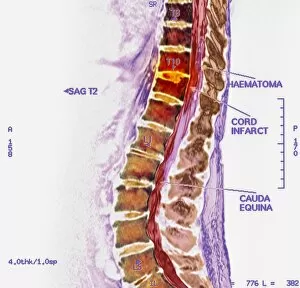Cauda Equina Collection
Cauda Equina: A Horseshoe-Shaped Tail of the Spinal Cord Calling for Urgent Attention
All Professionally Made to Order for Quick Shipping
Cauda Equina: A Horseshoe-Shaped Tail of the Spinal Cord Calling for Urgent Attention. In the intricate world of the human nervous system, the cauda equina, a bundle of nerves at the end of the spinal cord, plays a crucial role. Yet, this vital structure can be the silent culprit behind debilitating symptoms. A spinal cord stroke, often misdiagnosed due to its subtle symptoms, can lead to damage in the cauda equina. An MRI scan, a powerful diagnostic tool, can reveal the extent of the damage. Delve into the anatomy of the brain and spinal cord, as depicted in this 1844 artwork, to understand the complex relationship between the two. The brain, the command center, sends messages through the spinal cord to various parts of the body. The cauda equina, resembling a horseshoe, is the collection of nerve roots that originate from the lower end of the spinal cord. In the artwork, it appears as a series of delicate strands extending from the spinal cord. However, when the blood supply to the cauda equina is compromised, as in a spinal cord stroke, the consequences can be severe. Symptoms such as lower back pain, numbness, and bladder dysfunction may arise. An MRI scan, with its ability to provide detailed images of the spinal cord and cauda equina, can help in diagnosing a spinal cord stroke and determining the extent of damage. Early recognition and intervention are crucial in managing cauda equina injuries. Don't overlook the signs – your health depends on it.


